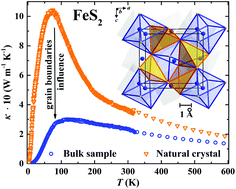Structural stability and thermoelectric performance of high quality synthetic and natural pyrites (FeS2)†
Abstract
Synthetic bulk and natural pyrite from the hydrothermal mine in Schönbrunn (Saxony, Germany) are confirmed to be stoichiometric FeS2 compounds and stable (for thermoelectric applications) up to ∼600 K by combined thermal, chemical, spectroscopic and X-ray diffraction analyses. Natural pyrite with a small amount (<0.6 wt%) of well-defined transition metal carbonates revealed characteristics of a nondegenerate semiconductor and is suitable as a model system for the investigation of thermoelectric performance. In the temperature range 50–600 K both natural and synthetic high quality bulk FeS2 samples show electrical resistivity and Seebeck coefficients varying within 220–5 × 10−3 Ω m and 4 – (−450) μV K−1, respectively. The large thermal conductivity (∼40 W m−1 K−1 at 300 K) is exclusively due to phononic contribution, showing a well pronounced maximum centered at ∼75 K for natural pyrite (grain size ≤5 mm). It becomes almost completely suppressed in the sintered bulk samples due to the increase of point defect concentration and additional scattering on the grain boundaries (grain size ≤100 μm). The thermoelectric performance of pure pyrite with ZT ∼ 10−6 at 600 K is indeed by a factor of ∼1000 worse than those reported earlier for some minerals and synthetic samples.



 Please wait while we load your content...
Please wait while we load your content...